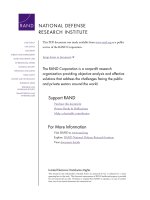PRESENT PROGRESS AND BEGOING TO
Bạn đang xem bản rút gọn của tài liệu. Xem và tải ngay bản đầy đủ của tài liệu tại đây (50.98 KB, 2 trang )
Period:
Preparing date:
Teaching date:
The present progress and “be going to”
I- Aims:
- The present progressive
- The present progressive vs. The present simple
- The future form of The present progressive vs. be going to
+ Language functions:
- Talking about the plans in the future.
II- Preparing:
+ Pupils have to review the main grammatical points which they have already
learnt.
+ Teacher has prepared some practical exercises
III- Teaching procedures:
Teacher s activities’ Students activities’
1- WARM-UP:
- Ask pupils to work in groups to prepare for
the game of making plan for next weekend.
- Call 3 representatives from the groups to talk
about their plans in front of the class.
- The winner is the one who has the most detail
talk about the plan.
- Call on some pupils to comment in front of
the class.
- Give the correction if necessary.
2- PRESENTATION:
a. The present progressive:
- Ask 2 pupils to go to the board to write the
formation and talk about the uses of the present
progressive tense.
- Call on some pupils to comment about the
formation and the uses of the present
progressive tense.
- Work in groups to discuss
- Talk about their plans in front of the
class
+ Go to the board to write:
P1: Formation:
(+) S + is/ am/are + V -ing + O + A
(+) S + is not/ am not/are not + V -ing +
O + A
(?) Is/ Am/Are + S + V -ing + O + A?
P2: Talk about the uses of the tense.
b. The present progressive vs. the present
simple tense:
- Ask pupils to work in groups to discuss about
the differences of the formation and the uses of
the two tenses.
- Call on some pupils to talk about the
differences in expression
- How to make a complex sentence using the
present progressive and the present simple
tenses.
c. The future form of The present progressive
vs. “be going to .”
- Call 2 pupils to go to the board to write the
formation of each structure.
- Ask the others to correct
- Ask some pupils to give some examples for
illustration.
3. PRACTICAL EXERCISES:
- Hang an extra board with exercises of
speaking, writing and reading on the board.
- Ask pupils to work in groups to do the
exercises.
- Ask some pupils to read the answers in front
of the class.
4. HOMEWORK:
- Ask pupils to revise the grammatical points of
the next lesson.
- Work in groups to discuss.
- Talk about the differences in expression
- Ask pupils to give examples to illustrate
the use of the complex sentences using
the present simple and the present
progressive tense.
- Write on the board:
P1: (+) S + be + O + A(in the future).
E.g: She is phoning him after finishing
her work.
P2: (+) S + be + going to + V-inf + O + A
(in the future)
- Work in groups to do the exercises
- Read the exercises in front of the class
- Prepare the next lesson.









